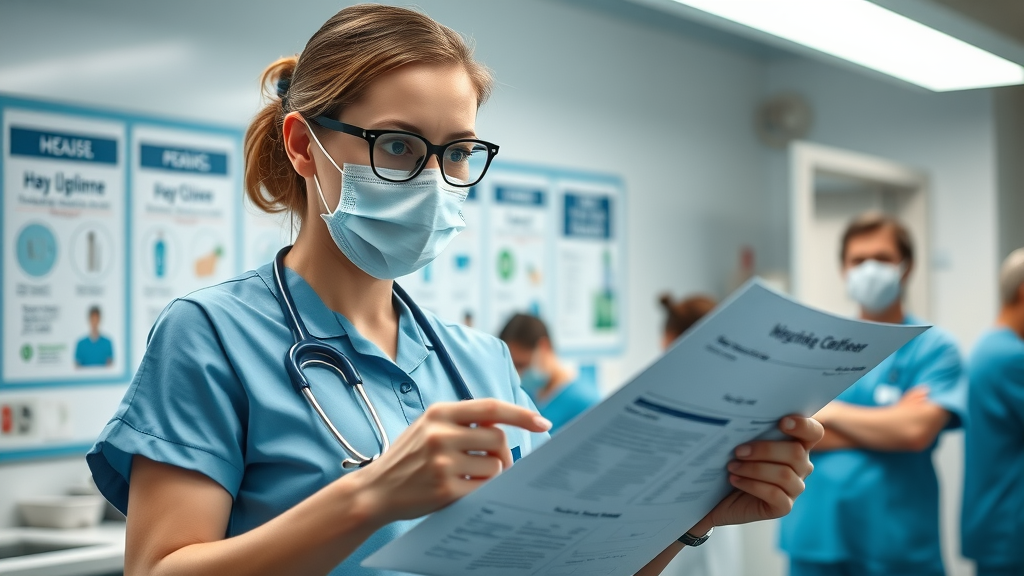Did you know that infection rates in long-term care facilities are higher than those in acute care hospitals? This puts both residents’ lives and facility reputations at risk. Yet, many of these infections are preventable with the right knowledge, protocols, and a strong culture of safety. In this comprehensive guide, you’ll uncover the core elements of infection prevention in long-term care , see real-world best practices, and learn the steps your facility must take to make every day safer for your residents and staff.

Unveiling the High Stakes of Infection Prevention in Long-Term Care: Why Every Detail Matters
Infection prevention in long-term care is more than a checklist—it's a crucial, ongoing mission. Recent data from the Centers for Disease Control and Prevention (CDC) shows that long-term care facilities face infection rates exceeding those in hospitals. This isn’t just a statistic; it’s a call to action. The risks aren’t just confined to resident health—outbreaks can tarnish a facility’s reputation and even result in regulatory penalties. Central to safeguarding residents is understanding why every detail of infection control matters, from daily hand hygiene to handling equipment and waste.
By the Numbers: Recent data reveals that infection rates in long-term care facilities outpace those in acute care hospitals—putting patient lives and facility reputation on the line. Are you aware of the true risks and consequences?
Taking infection prevention in long-term care seriously means appreciating the interconnectedness of all involved: residents, staff, visitors, and management. A failure in any link can allow infectious diseases—notably urinary tract infections and respiratory illnesses—to spread. This is why every protocol, procedure, and precaution matters.
Mastering Infection Prevention in Long-Term Care: Foundation and Framework
Defining Infection Prevention and Control in Term Care Facilities
Infection prevention and control in term care facilities refers to systematic measures that reduce the risk and spread of infectious diseases among residents, staff, and visitors. These processes cover routine cleaning, hand hygiene, appropriate use of personal protective equipment, and immediate response to outbreaks. Crucially, infection prevention operates in tandem with disease control and prevention to protect vulnerable populations that often have underlying medical conditions.
The ultimate goal is to establish protocols that everyone—from nurses to care workers to visitors—understands and follows. This unified approach safeguards the wellbeing of all within the facility and directly supports quality of care.
The Distinctive Challenges for Infection Prevention in Long-Term Care Facilities
Long-term care facilities face several unique hurdles when it comes to infection prevention and control. Residents are often highly susceptible due to advanced age, chronic diseases, or compromised immune systems. Shared living spaces, communal dining rooms, and regularly used medical equipment create opportunities for germs to spread quickly.
Resident vulnerability
Shared spaces and equipment
Staffing patterns
Underlying medical conditions
Additionally, staffing patterns and variable levels of training in disease control make infection control an ongoing challenge. Effective prevention and control measures must address these complexities, ensuring that policies are both comprehensive and realistic for everyday practice in term care facilities.

Establishing a Culture of Prevention and Control
A culture of infection prevention in long-term care is built on everyday habits. It’s not simply about policies—it’s about nurturing an environment where everyone is accountable. From leadership to frontline staff, all must embody vigilance, quick response, and open communication. When infection prevention becomes part of the facility’s DNA, it leads to lower infection rates and healthier outcomes.
"Infection prevention is not a single act, but a culture woven through every thread of long-term care." — Infection Control Expert
This culture requires ongoing education and feedback, where staff are encouraged to speak up about concerns and suggest improvements. Over time, sustaining these attitudes ensures not just compliance, but true commitment to resident safety and well-being in care facilities.
Key Elements of Successful Infection Prevention in Term Care Facilities
Leadership Commitment to Infection Prevention and Control
It’s impossible to overstate the importance of strong leadership in infection prevention and control. Facility managers and supervisors set the tone for a robust safety culture. Their commitment determines how seriously staff approach daily tasks like hand hygiene, personal protective equipment usage, and policy adherence. Good leaders implement rigorous auditing, encourage constant feedback, and prioritize staff training.
Leadership also ensures infection prevention resources are available and understood by all. This proactive attitude not only prevents outbreaks but also inspires trust among residents and family members—further supporting the overall mission of disease control in care facilities.
Dedicated Infection Control Professionals: Role and Impact
Dedicated infection control professionals, such as infection control nurses, are pivotal in establishing and reinforcing best practices in long-term care settings. These experts set protocols, monitor adherence, investigate outbreaks, educate teams, and continuously update guidelines to match evolving standards and threats.
Their expertise bridges the gap between regulatory requirements and real-world application, ensuring that every policy translates into safe daily action. By mentoring staff and tracking performance indicators, they drive ongoing quality improvement in term care facilities.

Education and Ongoing Training for Health Care Staff
Comprehensive and regular training for health care workers is non-negotiable in infection prevention and control. Staff must understand disease mechanisms, master hand hygiene, and become proficient with personal protective equipment, cleaning standards, and emergency protocols. Frequent training refreshers are critical as best practices and guidelines change.
Education is enhanced with practical demonstrations, scenario-based learning, and ongoing competence checks. This approach ensures that infection prevention knowledge truly translates into safer bedside behaviors in assisted living and nursing home settings.
Essential Roles and Responsibilities for Infection Prevention in Term Care Facilities
Role |
Core Infection Prevention Duties |
|---|---|
Frontline Staff |
Hand hygiene, correct PPE use, routine cleaning, reporting concerns, adhering to facility protocols |
Infection Control Coordinator |
Policy development, staff education, monitoring compliance, outbreak management, auditing outcomes |
Facility Leadership |
Resource allocation, culture setting, regulatory compliance, facilitating ongoing training |
Hand Hygiene: The Cornerstone of Infection Prevention and Control
Best Practices in Hand Hygiene for Term Care Facility Staff
Hand hygiene remains the single most effective measure for infection prevention in long-term care settings. The World Health Organization’s five moments for hand hygiene—before touching a resident, before clean/aseptic procedures, after risk of body fluid exposure, after touching a resident, and after touching resident surroundings—should be instinctive to every health care worker.
To ensure optimal disease control, staff must use alcohol-based hand rubs or wash hands thoroughly with soap and water. This should become routine before and after resident contact, before meals, after restroom use, and whenever contamination is possible. Consistently following these protocols drastically reduces the risk of spreading pathogens that cause respiratory or urinary tract infections.
Hand Hygiene Compliance: Monitoring and Improvement
Compliance with hand hygiene protocols is essential but often challenging. Monitoring involves direct observation, the use of compliance checklists, and feedback loops. Facilities may install sanitizer dispensers in strategic locations, conduct random audits, and publicly share compliance rates to motivate improvement.
To foster improvement, team leaders recognize exemplary behaviors, address barriers such as heavy workloads or skin sensitivities, and continuously educate staff about the real consequences of lapses—both for residents and the facility's reputation.
Empowering Residents and Visitors in Infection Prevention
Residents and visitors also play pivotal roles in infection prevention. Education campaigns, prominently placed reminder signs, and accessible hand sanitizer encourage everyone to participate. Teaching residents to clean hands before meals and after personal care activities enhances the entire infection prevention and control process.
Quick guide: Moments for hand hygiene
Real-world scenarios
Overcoming common barriers
Empowering non-staff participants helps establish a more resilient, community-based approach to disease control and prevention in term care facilities.
Personal Protective Equipment: A Critical Infection Control Tool in Nursing Homes
Types of Personal Protective Equipment Used in Care Facilities
Personal protective equipment (PPE) is indispensable for protecting residents and staff in nursing homes and other term care facilities. Common types include gloves, masks, gowns, and face shields. Each is used in certain situations depending on the risk level, type of care being provided, and the presence of specific infectious agents.
PPE acts as a physical barrier, preventing the transfer of pathogens via hands, air, or surfaces. Proper storage and regular inventory checks ensure supplies are available when needed—a lesson reinforced during global health emergencies like COVID-19.

When and How to Use Protective Equipment for Disease Control and Prevention
The appropriate use of PPE is dictated by the type of care provided and the infection control risks involved. For example, gloves are mandatory when handling blood or bodily fluids, while masks and gowns may be required during outbreaks or when caring for residents with respiratory symptoms. Staff should always refer to official guidelines—available via gov websites and official government resources—to remain up-to-date.
Using PPE correctly means donning it before exposure risk and removing it without contaminating yourself, others, or nearby surfaces. Staff must carefully follow checklists for donning and doffing to ensure complete safety.
Challenges and Tips for PPE Compliance Among Staff in Term Care Settings
Despite understanding the importance of PPE, staff may face barriers to compliance such as time pressures, discomfort, or unclear protocols. Leadership should routinely review practices, encourage questions, and provide immediate feedback to reinforce proper PPE use.
Checklist for Donning and Doffing PPE
Common PPE Mistakes and How to Avoid Them
Staff must also be vigilant about PPE supply and report any shortages. Consistent reminders and easy access to equipment help foster compliance and protect everyone within the facility.
Environmental and Equipment Sanitation in Infection Prevention and Control
Routine Cleaning Protocols for High-Touch Surfaces in Term Care Facilities
Environmental cleaning is a fundamental part of infection prevention and control. High-touch surfaces—handrails, door handles, elevator buttons, and bedside tables—require rigorous and frequent sanitization routines. Standardizing protocols and using approved disinfectants minimizes the chance of cross-contamination and disease transmission in care facilities.
Janitorial staff must clearly understand schedules, cleaning agents, and disposal instructions. Offering training and providing visual reminders ensures these high-traffic areas remain as sterile as possible.

Disinfection Practices for Shared Equipment in Long-Term Care
Medical devices such as blood pressure cuffs, glucose monitors, and thermometers often move between residents. After each use, this equipment must be properly disinfected following manufacturer and facility guidelines. Not only does this prevent the spread of infections like urinary tract infection, but it also demonstrates the facility’s commitment to best practices.
Staff should regularly audit disinfection procedures, report defective or damaged equipment, and never shortcut cleaning steps—even under time pressure.
Safe Laundry and Waste Management for Disease Control
Laundry and waste management are often-overlooked aspects of disease control and prevention. Dirty linens, clothing, and incontinence products must be handled carefully to avoid unnecessary exposures.
Use color-coded bins, wear appropriate PPE, and follow step-by-step processes as outlined by your local health care authority. Regular training on these protocols keeps everyone—including residents—safe from preventable outbreaks in nursing homes and assisted living facilities.
Outbreak Response: Advanced Disease Control and Prevention Strategies
Outbreak Identification and Immediate Action Plan for Term Care Facilities
Early recognition and swift response are critical when an infection outbreak is suspected in a term care facility. Staff should be trained to recognize symptoms, track unusual clusters of illness, and immediately alert infection control professionals. Quick identification allows for the isolation of affected residents, the implementation of heightened hygiene and PPE measures, and the notification of family members as necessary.
Having a well-rehearsed action plan ensures staff remain calm and effective during these high-stress situations, mitigating the scale and consequences of the outbreak.

Cohorting, Isolation, and Communication During Disease Outbreaks
Cohorting involves grouping residents who are infected with the same illness together and assigning dedicated staff to them. This minimizes the risk of transmission to healthy residents and staff. Isolation protocols may involve room restrictions, visitor limits, and task-specific PPE requirements.
Clear communication—via memos, signage, and direct staff briefings—is key. It ensures everyone knows their roles and the rationale behind specific measures, promoting unity and calm amidst crisis.
When to Involve Public Health Agencies for Infection Control
Certain outbreaks require more than in-house expertise. Facilities must know when to reach out to local or national public health agencies—such as the Centers for Disease Control and Prevention or their state health department. These groups offer guidance, diagnostic support, emergency supplies, and even on-site assistance if needed.
Never hesitate to seek expert help—timely coordination prevents escalation and assures families that their loved ones are in capable hands.
Beyond the Basics: Advanced Prevention and Control Tactics in Long-Term Care
Vaccination and Antimicrobial Stewardship in Care Facilities
Vaccinations are a cornerstone of prevention and control for influenza, COVID-19, and pneumococcal diseases in long-term care. Proactive vaccination campaigns among residents and staff protect against seasonal and emerging threats. Antimicrobial stewardship programs help to ensure that antibiotics are prescribed appropriately, minimizing drug-resistant infections.
Regularly reviewing vaccination status and tracking medication use further strengthens the overall infection prevention strategy in care facilities.

Emerging Technologies and Surveillance for Infection Control
Digital surveillance tools, real-time infection tracking, and rapid diagnostic tests are revolutionizing infection prevention and control. These tools detect outbreaks faster, automate reporting, and provide actionable data to leadership. Adopting new technology not only improves response times but also identifies trends, gaps, and future risks in term care facilities.
"Every new technology is a new tool in the fight for safer long-term care. Embrace innovation." — Senior Care Technologist
Facilities that invest in innovation set themselves apart and ensure the safety and trust of both staff and residents well into the future.
Staff and Family Engagement: Sustaining an Infection Prevention Culture
Effective Communication and Training for Staff and Visitors
A facility’s infection prevention culture hinges on clear two-way communication between staff, residents, and families. Ongoing education about protocols, disease symptoms, and response plans increases adherence and reduces anxiety. Staff briefings, visitor orientations, and written reminders keep everyone informed and empowered.
Active engagement helps residents and families buy into prevention strategies, creating a united front against infectious threats in term care facilities.
Promoting Infection Prevention Advocacy in the Wider Healthcare Community
Long-term care facilities are integral to the broader healthcare ecosystem. Partnering with local hospitals, pharmacies, and public health agencies creates a safety net for residents moving between levels of care. Advocacy efforts—such as training sessions, awareness campaigns, and community outreach—extend infection prevention best practices beyond facility walls.

Common Infection Prevention Pitfalls in Term Care and How to Avoid Them
Top 7 Infection Prevention Mistakes in Term Care Facilities
How to Fix Each
1. Inconsistent hand hygiene: Address with reminders and accessible sanitizers.
2. Improper PPE usage: Reinforce with training and direct observation.
3. Inadequate surface cleaning: Implement clear checklists and routine audits.
4. Lax equipment disinfection: Assign responsibility and increase supervision.
5. Failure to recognize outbreaks: Use surveillance tools for early detection.
6. Poor communication: Formalize updates and encourage feedback.
7. Insufficient training: Schedule regular, mandatory refreshers for all staff.
By addressing these pitfalls, infection prevention in long-term care becomes not just a protocol but an ingrained practice.
How to Measure Success: Infection Prevention Metrics for Long-Term Care Facilities
Key Performance Indicators for Infection Prevention and Control
Tracking your facility’s infection prevention progress is essential for continuous improvement. Key performance indicators (KPIs) can include hand hygiene compliance rates, PPE usage observations, environmental cleaning audits, vaccination coverage, and incident reports for healthcare-associated infections. Setting clear benchmarks and tracking data monthly helps leadership allocate resources and supports a culture of accountability.
Publishing outcomes and trends also motivates staff and reassures residents and families that safety is always a top priority within term care facilities.
Sample Infection Rate Tracking Table for Nursing Homes
Unit |
Jan |
Feb |
Mar |
Apr |
|---|---|---|---|---|
Memory Care |
4.5% |
3.8% |
3.1% |
2.9% |
Skilled Nursing |
5.2% |
4.7% |
4.0% |
3.6% |
Assisted Living |
3.7% |
3.5% |
3.0% |
2.7% |
Regularly reviewing this data enables early intervention and proof of continual improvement in infection prevention and control.
People Also Ask: What are the 5 infection prevention steps?
Answering: The Five Essential Steps of Infection Prevention
The five essential steps of infection prevention are: hand hygiene, respiratory hygiene, use of personal protective equipment, environmental cleaning/disinfection, and safe injection practices. These steps provide a comprehensive approach to blocking infection pathways in care facilities. Consistent application by staff, residents, and visitors forms the foundation of infection prevention in long-term care.
People Also Ask: What should staff do to promote infection control in long-term care facilities?
Answering: Proven Staff Strategies for Infection Control and Prevention
Staff should consistently practice hand hygiene, use personal protective equipment correctly, disinfect shared equipment and surfaces regularly, participate in ongoing infection prevention training, and promptly report any symptoms or outbreaks. By advocating these measures, every health care worker helps maintain a safer environment in nursing homes and term care facilities.
People Also Ask: What are the three C's of infection prevention?
Answering: The Three C's Explained for Effective Prevention in Care Facilities
The three C’s of infection prevention are: Clean, Cover, and Contain. “Clean” relates to thorough hand and surface hygiene; “Cover” refers to shielding coughs and sneezes; while “Contain” means isolating ill individuals. Rigorously applying these principles reduces the chance of infectious disease spread in all term care settings.
People Also Ask: What are the 5 F's of infection control?
Answering: Demystifying the 5 F’s of Infection Prevention in Long-Term Care
The 5 F’s of infection control are: Fingers, Food, Feces, Fluids, and Flies. Each represents a possible transmission route for infection. Proper hand hygiene (Fingers), safe food handling (Food), correct waste management (Feces and Fluids), and environmental control (Flies) all play key roles in comprehensive disease control and prevention strategies for long-term care.
Frequently Asked Questions on Infection Prevention in Long-Term Care
What role do residents play in infection prevention and control?
Residents play a critical role by following hygiene protocols, reporting symptoms early, and participating in facility infection prevention programs. Empowered residents help reinforce a culture of safety for everyone.How often should staff receive infection prevention training?
Staff should receive infection prevention training during onboarding and at least annually thereafter. More frequent updates are preferred, especially when new guidance from the centers for disease control and prevention is released.What’s the impact of emerging infections in term care facilities?
Emerging infections can lead to rapid outbreaks due to close living quarters and vulnerable populations. Facilities must stay alert with surveillance, vaccination, and up-to-date disease control protocols to quickly contain and mitigate risks.Are there new guidelines for personal protective equipment usage in nursing homes?
Yes. Guidelines continually evolve and now include specific directions for donning, doffing, and reusing certain types of equipment based on infection risks. It’s vital to regularly check the official government website or your local health care authority for the latest updates.
Key Takeaways for Infection Prevention and Control in Long-Term Care
Summary of critical strategies
Must-follow prevention and control steps
Leadership and teamwork reminders
An effective infection prevention strategy anchors on leadership support, ongoing staff education, vigilant monitoring, and community engagement. Through unified teamwork, constant improvement, and a commitment to best practices, facilities can create the safest possible environment for their residents.
Ensuring Success in Infection Prevention: Make Every Day Safer in Long-Term Care
For unmatched safety, elevate your infection prevention approach. Commit to ongoing training, vigilant hygiene, and rigorous protocols to protect every resident, every day.
To enhance your understanding of infection prevention in long-term care facilities, consider exploring the following authoritative resources:
The Centers for Disease Control and Prevention (CDC) offers a comprehensive Nursing Home Infection Preventionist Training program. This free course covers core activities of effective infection prevention and control (IPC) programs, recommended practices to reduce pathogen transmission, and provides tools such as policy templates and audit instruments. It’s designed for individuals responsible for IPC programs in nursing homes, including physicians, nurses, and administrators. (cdc.gov)
The SHEA/APIC Guideline: Infection Prevention and Control in the Long-Term Care Facility provides detailed recommendations on surveillance, facility design, and housekeeping to ensure a safe and sanitary environment. It emphasizes the importance of hand hygiene facilities, proper ventilation, and routine cleaning schedules to prevent infection transmission. (pmc.ncbi.nlm.nih.gov)
These resources offer in-depth insights and practical tools to strengthen infection prevention strategies in long-term care settings.
Article provided by:
Kenneth D. St. Pé, APLC
Address: 700 St John St #401, Lafayette, LA 70501
Phone: (337) 534-4043
Website: stpelaw.com
Facebook: facebook.com/stpelawfirm
 Add Row
Add Row  Add
Add 



Write A Comment